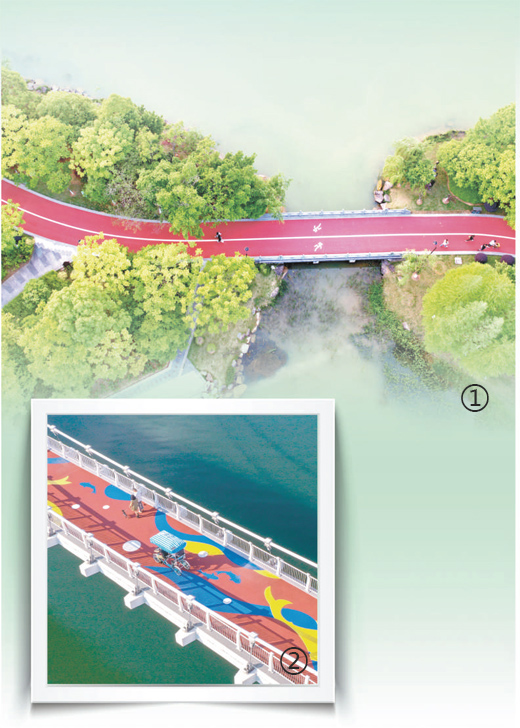Urban greenways across China enrich people's lives

①Photo shows a greenway inside a wetland park in Zhanggong district, Ganzhou city, east China's Jiangxi Province. [Photo/Zhu Haipeng]
②Photo shows a bicycle path built along Qiandaohu Lake in Chun'an county, Hangzhou city, east China's Zhejiang Province. [Photo/Yang Bo]
In recent years, Chinese cities have advanced the construction of urban greenways based on local conditions, which has created green living spaces for residents while further enriching their lives.
China has built more than 80,000 kilometers of greenways nationwide as of the end of 2021, statistics released by the Ministry of Housing and Urban-Rural Development (MOHURD) have shown.
"Greenways should connect residential areas, parks, and major cultural venues, and offer green living spaces that can enrich citizens' lives," said an official from the MOHURD.
Combing natural and cultural landscapes, urban greenways have become great places for citizens to relax and exercise, promoting green and coordinated development between urban and rural areas, and enabling people to share the benefits of eco-environmental progress, which is the most salient characteristic of China's construction of urban greenways, the official added.
The official introduced that local authorities across China are actively advancing the building of a greenway network at regional levels and in cities, counties and communities in alignment with systematic planning.
Meng Yongquan, a citizen in his 70s from Chongqing, a mountainous city located along the Yangtze River in southwest China, does morning exercise regularly at a local greenway near the Yangtze River. There are also recreational facilities for children such as slides and trampolines located near the greenway.
"I can take a walk, take care of my grandchildren, or do exercise here while enjoying the scenery of the Yangtze River," Meng said happily.
In Hangzhou, capital city of east China's Zhejiang Province, some greenways include smart running tracks, which can record runners' speed, steps, and the number of calories burned. Through a greenway-related mini program, people can locate nearby greenways, restaurants, and recreational facilities. Xiamen city in southeast China's Fujian Province has built a green and slow traffic system that includes greenways and bicycle lanes. In Chengdu, capital city of southwest China's Sichuan Province, the Tianfu Greenway is dotted with multiple sports facilities.
China will formulate a plan for a science-based urban slow traffic system and build bike lanes and greenways in light of local conditions, said a guideline on green development in urban and rural areas released by the General Office of the Communist Party of China Central Committee and the General Office of the State Council of China last year.
Wang Panyan, director of the science and technology committee under the China Urban Construction Design and Research Institute Co., Ltd., suggested that China should coordinate the planning, construction and operations of greenways to improve the construction quality and usage effectiveness of greenways, and strengthen the construction of greenways in communities, especially in old residential areas. Wang also called for the combination of greenways and slow traffic corridors.
The MOHURD will further enhance the construction of greenways in built-up areas of cities, improve service facilities for greenways, and guide local authorities to reasonably allocate service stations and supporting facilities to meet people's demand for getting closer to nature and engaging in leisure and fitness activities.
























